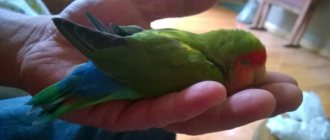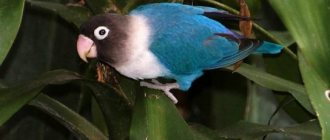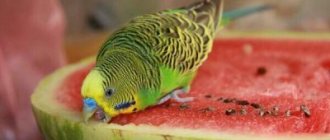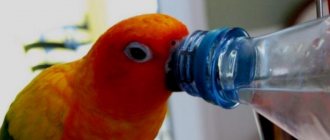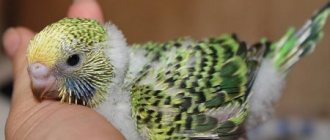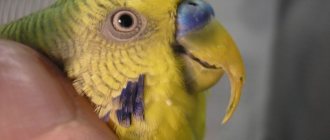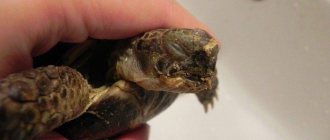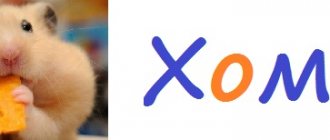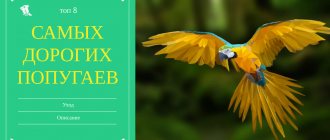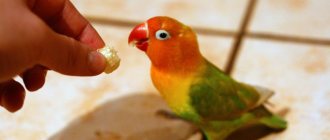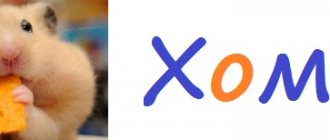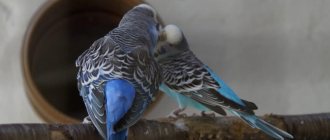The bright plumage of poultry is a sign of their health. There comes a time when all the colorful feathers remain at the bottom of the cage.
A bird breeder is saddened to realize that his pet is losing its attractive appearance. A million questions arise in his head: is this a normal process, at what time does it take place, is feather loss a symptom of some disease.
We can only reassure the unlucky bird lovers: molting in parrots is a normal process, it happens to every poultry 1 or 2 times a year.
Why does a parrot molt
Pet lovers often get parrots. When an inexperienced owner encounters a phenomenon such as molting, he begins to fear for the health of the pet. Normally, all birds periodically lose feathers, replacing which new ones grow. But molting is not always a physiological process. Budgerigars have pathological conditions that require correction and immediate veterinary attention.
Several reasons why budgies also lose feathers:
- genetic predisposition;
- frequent egg laying;
- poor care;
- stress, self-plucking;
- lack of protein.
Attention! There is a known pathology called “French molt,” when feathers fall out and no longer grow. The bird does not fly, becomes disabled, and sometimes even dies.
Frequency of shedding
Wild budgerigars moult annually: after winter, the birds shed their warm, worn-out “clothes” and put on light clothes. Tame wavy birds, familiar from birth only with their home environment, lose their feathers once or twice a year. Each bird has its own molting period, depending on individual characteristics and living conditions. Some individuals may not shed at all for a year or more, this is also a variant of the norm.
The natural process occurs in spring-autumn, as well as in the first months after the chicks hatch. Beginning breeders do not know how long it takes for a budgerigar to shed. Many people become alarmed if their feathers don't grow. The normal duration is on average 4 - 5 weeks, and in young animals molting lasts from three to five months.
First time
Already at four months, the chick begins to experience its first molt: in budgerigars it lasts intermittently and ends closer to a year. At this time, down falls out, and dense feathers designed for flight grow. A young parrot acquires its true coloring; it will not change throughout its life. At the end of the baby molt process, also called juvenile, the bird is considered mature. It is already possible to visually determine gender.
This is interesting! By analogy with humans, molting is similar to changing teeth. When permanent teeth grow in, the next stage of growing up begins.
If the budgerigar chick is already five months old and the juvenile moult has not yet begun, this may be a consequence of internal problems. Perhaps there is a deficiency or excess of some substances in the body. Environmental conditions are not always suitable for starting a natural cycle. To avoid guessing, consult your veterinarian.
Water and air
It doesn’t matter whether a parrot sheds heavily or sheds several feathers, in any case it needs to be provided with a comfortable atmosphere. First of all, you need to take care of the air humidity. Birds do not like dry air, especially when they moult. During this period, it is imperative to install a humidifier near your pet’s cage and select the optimal mode for its operation. Humid air will help the bird's skin recover faster, and it will feel more energetic.
Don’t be surprised when the question: “what to do if a parrot moults?” your veterinarian will answer, “bathe him.” Water treatments are beneficial for the bird, and if it expresses a desire to take a dip in the water, do not refuse it. To prevent bathing from affecting your health, follow the same conditions as when bathing children: no drafts, only warm water and a warm room. If the reasons we have mentioned do not help you understand why your parrot is constantly molting, ask your veterinarian.
Seasonal molt
An adult parrot has a full-fledged moult twice a year, and in between there is a slight loss of fluff. Superficial molting in parrots occurs due to changes in temperature, humidity, and daily routine. The main reason for the loss of feathers is their wear and tear. Spent feathers cannot fully retain heat and prevent the bird from flying.
The moment when the seasonal molting of a budgerigar begins can be determined by the presence of fallen fluff. This is not particularly noticeable in the appearance of the bird: the change of plumage occurs smoothly, without the appearance of bare areas of skin. Blood gradually stops flowing to old feathers, they dry out and fall off, or the budgie pulls them out with its beak.
The sequence of feather changes: first the feathers fall out on the belly and chest, then on the back and head. At the same time, new ones are growing. The last feathers to change are on the wings in pairs, as well as on the tail. The largest ones can remain on the body for more than a year.
Parasitic diseases, mycoses
Pathogenic fungi, scabies mites, and other ectoparasites that can infect a feathered pet can also cause intense feather loss. Mycoses most often develop against the background of decreased immunity, due to non-compliance with hygiene rules. The fungus can be brought with food from a pet store.
With scabies (knemidocoptic mange), you can notice bald spots not only on the body in the area of the wings, but also on the paws. The affected surfaces have a lumpy structure and become red in color. The skin is thickened and flaky. Cracks, small bumps, and red spots are visible on the surface of the body. Lost feathers look untidy. In severe cases, the wax, beak, and paws are affected. Feathers fall out in clumps, unevenly.
If a bird is sick with mycosis or infected with ectoparasites, we do not recommend bathing it, much less self-medicating. Therapeutic therapy should be selected by a veterinarian ornithologist.
How to understand that a parrot has started molting
If feathers appear to be falling out from time to time near or inside the cage, this does not always mean that the parrot is molting. It is likely that such a mess is a consequence of combing or fighting. True molt has several features.
Among the signs and symptoms of molting in budgies are the following:
- the wavy pattern disappears;
- the plumage becomes loose and ruffled;
- white columns are found on the body;
- the skin is strewn with dandruff;
- the bird is tormented by itching;
- the wavy does not sleep well and can be aggressive;
- the pet's appetite worsens;
- the need for communication decreases.
Important! Too frequent episodes of feather loss indicate self-plucking. It occurs in birds for physiological or psychological reasons.
During molting, the parrot often itches, trying to relieve the itching of the skin. This is a consequence of the vital activity of parasites - knemidocoptosis. In suspicious cases, a veterinary examination is advisable. In order for the molting to take place faster and without harm to health, you need to help your ward a little.
Choosing the optimal type of nesting site
So, let's look at 3 types of nesting houses for parrots. A vertical housing is characterized by a high location of the entrance, which increases the likelihood of damage to eggs by birds. But the chicks cannot fall out of it.
In a horizontal house, the eggs will be reliably protected, in addition, the grown chicks will look out of it and watch with interest what is happening in the room. Parrots will really like the combined nest box, because it combines the advantages of the previous options. Such a dwelling is spacious enough and convenient for raising a large number of chicks.
Anyone can make a house for budgies with their own hands.
Simple vertical house
It is best to make a vertical house for budgies with your own hands from hardwood boards, the thickness of which is no more than 20 mm. First you need to carefully cut out the front, back and side walls of the box. All parts must be the same length and width! The standard dimensions of a home for a pair of budgies are 15 x 15 x 25 cm. Now you can connect the walls of the future home with nails. The bottom of a smooth board should fit them perfectly. To prevent the female from scattering eggs and small chicks along the bottom of the nesting house, it is recommended to make a slight depression in it.
The diameter of the tap hole (inlet) in the front wall of the box is 50 mm. It can be cut using a drill. It is also worth making cutouts. After all, fresh air is very important for the full development of eggs and chicks. It is advisable to attach a piece of plywood inside the nest box as a lip to protect the eggs. Otherwise, the parrot risks damaging them.
It is necessary to drill a hole under the finished taphole to fix a short perch. This is done to make it convenient for birds to enter the home. After all the structural parts are connected to each other, the box must be covered with a lid. A simple and convenient nesting box for parrots is ready! You can secure it to the cage using wire or hooks.
Combined nesting house
A nest box of a combined type is suitable for large budgies. Such a dwelling is quite spacious, so the female does not risk damaging the clutch, and the growing chicks will not be able to leave it prematurely. To make it you will need the same materials as for the vertical house. The height of the combined nesting box is at least 20 cm, and the internal size of the bottom is 22 x 15 cm. The entrance with a perch is located 2.5 cm from the ceiling and front wall. Inside the nest box you need to make a step 3 cm high so that the parrots can comfortably enter it. Do not forget that you need to make a round depression at the bottom for eggs and chicks.
It is recommended to equip such a nesting box with a hinged lid. This way, it will be possible to carry out a daily inspection of the box and remove dirt in a timely manner. The removable cover can be installed using hinges and screws.
Horizontal nest box
How to make a horizontal type nest for budgerigars? It is no secret that this type of nest box is very convenient for the female and her offspring. Kids will be able to look out of it and watch the adult birds with interest. In fact, a horizontal dwelling is designed in the same way as a vertical one.
In the process of making such a nest, you will need the same wooden boards, plywood and nails. From a wooden board you need to carefully cut 2 rectangles measuring 25 x 15 cm, which will serve as the front wall and bottom of the home. Then cut out the side walls in the same way. The recommended size is 15 x 14 cm. Use a sheet of plywood to make a back wall (23 x 15 cm) and a lid (25 x 15 cm) for the house. Using nails, fasten the front wall and the bottom of the future nesting box, then attach the side walls to the edges.
When the base of the dwelling is ready, you can begin drilling the taphole. Its diameter is 50 mm. Just below the entrance, use a drill to make a hole for the perch. How to make a removable nesting cover without using metal hinges? Drill several holes along the upper edge of the back wall at equal distances from each other. The same holes should be drilled along the edge of the box roof. The main thing is that the holes coincide with each other. Now, using rope, secure the roof to the base of the nest box.
The bottom of the box can be divided into 2 parts by attaching a wooden strip in the center. Thanks to this, small chicks will not be able to crawl close to the entrance hole.
Caring for a parrot during molting
When budgerigars molt, their coat becomes sparse. Heat-loving birds are chilly and sit on a perch. During this difficult period, babies need special care from their owner. You will have to organize comfort and increased control for your parrot:
- heat the room, humidify the air more than usual;
- eliminate drafts;
- monitor the bird during a walk, protecting it from injury;
- give mineral and vitamin supplements;
- supply the wavy with twigs that are so convenient to itch;
- observe the light regime and do not interfere with the bird’s sleep;
- provide the opportunity to swim.
Attention! There is an opinion that a parrot should not leave the cage and fly during molting, otherwise it may fall. In fact, this point of view is not entirely correct, because the tail and flight feathers change symmetrically. The balance necessary for flight is maintained.
General rules for caring for a shedding pet involve creating conditions that are as close to natural as possible. In their natural environment, birds themselves do everything possible to prevent molting from causing them inconvenience.
Next, we will consider in detail what to do if a budgie moults.
Nutrition
Increased metabolism requires increased energy expenditure. During the period of seasonal molting, budgerigars develop a deficiency of micro and macroelements. A balanced feed suitable for molting birds is required. This is any grain mixture with o. It forms the basis of the diet. In addition, we must not forget about succulent food:
- fruits (apple, pear, banana);
- vegetables (carrots, pumpkin, beets);
- greens (nettle, tops of seasonal root vegetables);
- berries (lingonberries, grapes, currants).
If you can’t diversify your diet, you should feed your pet with vitamins: add a few drops of a veterinary drug to the grain.
You need to include protein foods in your diet - low-fat cottage cheese, boiled eggs. They are especially useful when your pet budgie is shedding. A free bird swallows insects and makes up for the lack of protein, and the owner can bring mealworms from a pet store to a tame pet.
Sepia, chalk, egg shells, cuttlefish shell - this mineral supplement enriches the body with microelements. Sulfur promotes the formation and growth of feathers; you cannot do without it during the molting period. This component is added at the tip of a knife to the birdseed.
Air humidity and swimming
When she molts, the parrot becomes nervous, irritable, and aggressive. Something is constantly bothering him, he feels discomfort. Such an unpleasant symptom of molting as itchy skin can be easily relieved with water. The feathered pet wants to swim whenever possible.
Even among good-natured parrots there are harmful individuals who cannot be pleased. If your capricious one refuses to splash, carefully pour water on him and refresh his feathers. This can be done using a spray bottle or water pistol by spraying water over the cage.
This is interesting! In nature, wavy birds bathe in dew and rain, and at home they love to rinse off under the tap.
It is important to remember that when delicate budgies molt, they require a moist environment at home. Dry air increases discomfort, which is especially noticeable when heating appliances are operating. Relative humidity should be maintained at 60%. There is a fairly simple solution for this - a household humidifier. But if you don’t have one, you can hang wet towels.
First aid for a bird
Many owners of feathered pets, and especially beginners, are often lost and do not know what to do when they notice the first loss of feathers in their parrots. However, in this case, you should not be alarmed - it is recommended to make an appointment with a veterinarian as soon as possible, who can accurately determine the cause, as well as prescribe the correct treatment.
At home, when self-plucking, you first need to treat the tail with a bitter spray (for example, Beafar Spray) or a soda solution, which can discourage the desire to pull out feathers.
You can also use a special collar, which can temporarily protect feathers and skin from additional beak injuries. The drug “Aloe Vera” is well suited for treating the skin, which is an antiseptic and hemostatic agent, while simultaneously softening and moisturizing irritated skin.
In case of injuries, they should be treated with hydrogen peroxide or a solution of Eplan, Ditsinon, or Etamzilat. After the bleeding has been stopped, the wound needs additional disinfection - Betadine, Chlorhexidine, Miramistin are well suited for these purposes. At the same time, you should absolutely not use alcohol, iodine or brilliant green.
Did you know? Parrots can be right-handed or left-handed
—In order to determine this, you just have to take a closer look at which paw the bird most often uses to take food or open the cage door.
Possible complications
A bird does not always lose feathers because nature requires it. Sometimes it is not clear why a parrot sheds so much. There are several pathologies that require medical intervention:
- French molt. A serious illness that has not been thoroughly studied. The normal cover disappears almost completely, and defective, weak feathers grow on the skin. The bird cannot fly and remains disabled. Ornithologists suggest that a sick parrot sheds too much due to a lack of protein food and poor care. The disease is incurable.
- Self-plucking. Little birds are very vulnerable and subject to stress. Melancholy, hunger, and fear are often the reasons why a budgie begins to pluck its feathers. If you adjust the living conditions of the bird, the pathology will go away on its own.
- Knemidocoptic mange (scabies). Another reason for partially falling out feathers in a budgerigar. A bird infected with parasites loses feathers in the folds of its skin and on its limbs. Exposed parts of the body turn red and become covered with tubercles. The veterinarian diagnoses the disease and prescribes treatment.
When a parrot begins to molt, the poultry farmer must anticipate possible troubles. Regular physiological molting is associated with some discomfort. You can be sure that good care, increased nutrition and tender human care will help birds survive this process. And in a couple of months, the parrot’s beauty and love of life will return.
If you liked the article or have something to add, leave your comments and also join our VKontakte group.
Possible causes of self-plucking
Feather plucking is usually accompanied by some other symptoms. Taking them into account, the doctor determines the possible reason for this behavior:
- Improper living conditions often cause self-plucking. In the room where the bird is kept, the air should not be dry. The parrot has very dry skin. This is due to the anatomical features of his body, which does not have some glands. As a result, the pet needs to be bathed. If the owner forgets about this, the bird experiences discomfort.
- The presence of parasites is a fairly common reason for a parrot to pluck feathers on its chest and entire body. He is irritated by the activity of lice eaters and mites, and as a result he pulls out feathers in places of irritation. Treating your pet's feathers with dry wormwood or chamomile will help. In such cases, the cell is treated first with turpentine, then with boiling water.
- Feeding your feathered friend improperly also causes him to start pulling out his feathers. Once a week, the pet should receive protein food. This can be a boiled egg, yogurt, low-fat cottage cheese or minced meat. During molting, squirrels are given to the bird twice a week. When a parrot is hatching eggs or feeding chicks, it will need such food daily. The amount of protein food depends on the type and size of the parrot. For small species, food the size of a cherry berry will suffice.
- If a parrot plucks feathers on its butt, this indicates possible diseases of the intestines and other internal organs. In this case, you cannot do without a full examination. In a female parrot, a plucked butt indicates a possible pregnancy.
- To maintain good health, parrots need to include fresh vegetables, herbs and fruits in their diet. Even if your pet once refuses a fruit or vegetable, you should offer it until the bird tries and likes the healthy treat.
- Poultry nutrition will not be complete without grain feed. Each type of grain contains the substances it needs. Therefore, it is recommended to alternate wheat, oats, corn and millet as feed. However, if the doctor suspects a thyroid pathology in the parrot, oats should be excluded from its diet. It contains substances that suppress the activity of this organ.
- Stress is recognized as the most commonly identified reason for a parrot to pluck feathers under its wings and elsewhere. These birds have a highly developed psyche. They are very sensitive to the home atmosphere and have a hard time with a change of place of residence or owner. Any change in the usual way of life causes stress or so-called frustration in the parrot. If this condition lasts for a long time, the pet becomes either depressed or too active. In both cases, the parrot plucks its feathers until it bleeds, and the sooner help is provided to it, the faster it will come to its senses.
